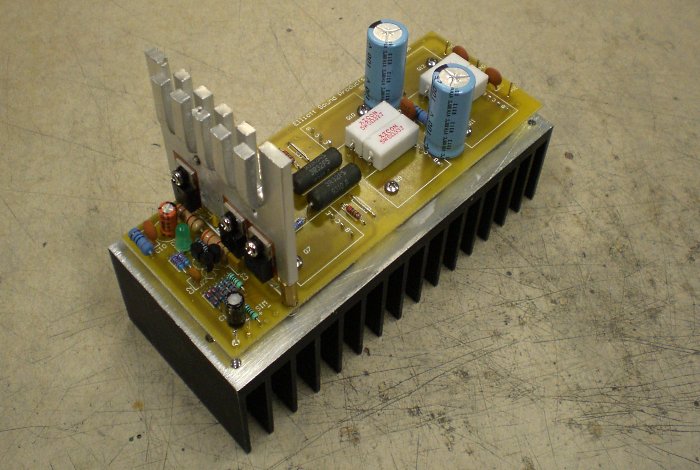An experiment with HEXFETs.
Page 1 | Page 2 | Page 3 | Page 4
With the plate amplifier completed and tested, only one step remained, and that was to install the unit into its cabinet. Following my general suggestions, my friend had built a cabinet very similar to my P68 cabinet, including a false back, but with only a cheap twelve inch (300mm) driver due to limited funds. Unfortunately no pictures were obtained, in part because of what happened next.
The plate was installed, audio and power were connected, and power cycled on as expected. The amplifier drove a satisfying bass range for a couple seconds...and then suddenly cut out. Mystified, I tweaked the level control and phase switch, expecting to located a bad connection. No results. Power was cycled to the unit. Still no results.
That is, until a loud *SNAP* was heard, and smoke suddenly began pouring out of the unit. Horrified, we pulled all cords from the unit immediately, and the plate was quickly uninstalled. The immediate prognosis was that both decoupling capacitors for the daughterboard had inexplicably fired off like .22 shells, which also accounted for the impressive volume of smoke that was released. Both rail fuses were severely warped and the positive rail fuse element had just barely broken. No other visible damage was present, so the unit went into more advanced troubleshooting the next day.
Final prognosis: every HEXFET in the positive-rail output stage had failed, and in typical failure fashion, each was showing between 20-50Ω resistance. The resulting high-current sink had caused the decouplers to exceed their ripple current rating and fail from overheating, at which point the short-circuit current across them finally finished off the rail fuse. The sudden cutout we had experienced was, in fact, P33 functioning exactly as it ought to, which was something of a small comfort. Emphasis on 'small', since the majority opinion was frustrated disappointment.
Probable cause for all of the above? Liam, after hearing my troubleshooting results, pointed out that the FET gate is a capacitive device, and the sub driver's magnetic field had apparently been strong enough to open all of the positive-rail gates at some point, starting the chain reaction. Unfortunately, it would be a lot of work to disassemble and then rebuild the failed amplifier, and there was no guarantee that the amplifier region could be suitably shielded to prevent an immediate repeat. Now what?
The final decision was to throw together a single-board P68, which would fit in the available space and support an 8Ω-nominal driver at 65V rails. It was also the quickest fix that could be arranged, since I had a full set of parts on hand, and Liam had a spare ESP P68 board that he was willing to swap for the damaged prototype:

Figure 17. The P68 amplifier assembled on a temporary heatsink.
The predriver heatsink is excessive, but when you get them for free out of failed switching power supplies,
there's no point letting them go to waste.
A new heatsink mounting plate was designed and cut to fit in the same fashion as the original amplifier, and
the P68 was mounted and wired in place of the original. A P33 failure was traced back to a resistor that had
apparently died in the original brouhaha, and was corrected. And everything worked...this time, unaffected by
the presence of the nearby driver.
So, I sought a learning experience, and that was exactly what I got: I prototyped an amplifier design, I tested and modified it, I accidentally blew it up, and I then reverse-engineered the failure mode. Could have done without that last part, but then again, maybe not. The process really was a valuable learning experience, and the lessons from that build have stuck in my head better than anything else I've done so far.
Optimized for a 1024 viewing width ~//~ All content (c)2008 aaronv.net